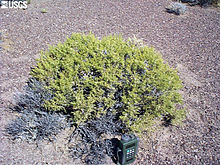Sarcobatus
| Sarcobatus | |
|---|---|
 |
|
| Sarcobatus baileyi | |
| Scientific classification | |
| Kingdom: | Plantae |
| (unranked): | Angiosperms |
| (unranked): | Eudicots |
| (unranked): | Core eudicots |
| Order: | Caryophyllales |
| Family: |
Sarcobataceae Behnke |
| Genus: |
Sarcobatus Nees |
| Species | |
|
see text |
|
| Synonyms | |
|
|
see text
Sarcobatus, is a North American genus of two species of flowering plants, formerly considered to be a single species. Common names for S. vermiculatus include greasewood, seepwood, and saltbush. Traditionally, Sarcobatus has been treated in the family Chenopodiaceae, but the APG III system of 2009 recognizes it as the sole genus in the family Sarcobataceae.
The Sarcobatus plants are deciduousshrubs growing to 0.5–3 m tall with spiny branches and succulent leaves, 10–40 mm long and 1–2 mm broad. The leaves are green, in contrast to the grey-green color of most of the other shrubs within its range. The flowers are unisexual, with the male and female flowers on the same plant and appear from June to August. The species reproduces from seeds and sprouts. S. vermiculatus was discovered in 1806 by the Lewis and Clark expedition's westward exploration of North America.
The Sarcobatus area of distribution is western North America, from southeastern British Columbia and southwest Alberta, Canada south through the drier regions of the United States (east to North Dakota and west Texas, west to central Washington and eastern California) to northern Mexico (Coahuila).
Both Sarcobatus species are halophytes, usually found in sunny, flat areas around the margins of playas and in dry stream beds and arroyos. It is replaced by iodine bush in extremely saline environments, such as hummocks within the playa itself. Greasewood often grows in extensive, nearly pure stands in pluvial desert locations and is most common on fine-grained soils in areas with a relatively high water table.
...
Wikipedia
